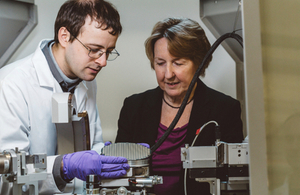Anvil Semiconductors: lighting the way on LED technology
A semiconductor business and its partners have developed a first-of-its-kind technology to make LED lighting better and more efficient.

Anvil Semiconductors, Chief Executive Jill Shaw and the company's LED technology.
Power device developer Anvil Semiconductors and its partners, the University of Cambridge and Plessey Semiconductors, have come up with a way to cut the cost of LED lighting and increase its efficiency.
Higher currents and temperatures, faster switches
Anvil Semiconductor’s innovation involves building cubic gallium nitride on top of cubic silicon-carbide technology.
Silicon carbide is a type of semiconductor that is commonly used in high-endurance applications - such as car brakes and clutches - or power devices. It allows these devices to work at voltages up to 10 times higher, carry higher currents, work at increased temperatures and switch much faster than silicon.
Gallium nitride is set to be the next big semiconductor for power electronics. Like silicon carbide, it supports much higher efficiencies and outperforms silicon in speed, temperature and power handling.
While silicon carbide and gallium nitride offer new levels of performance in LED lighting, until now their high cost has been a barrier to adoption.
Cutting the cost
Anvil’s innovation cuts the cost of using these compounds in LEDs.
It has already developed a way of building silicon carbide on to a traditional silicon base, or ‘wafer’, to make its advanced power switches for the same cost as silicon.
Now, a series of projects have shown that it is possible to grow cubic gallium nitride on top of the cubic silicon carbide, without a marked increase in production costs - a breakthrough that could transform the LED lighting market through new efficiency, cost and performance enhancements.
The projects were funded through the Energy Catalyst, which supports business and research to address major challenges in the energy sector. It is funded by Innovate UK and partners including the Department for Business, Energy and Industrial Strategy, the Department for International Development and Engineering and Physical Sciences Research Council.
Development is the first of its type
Anvil Semiconductors chief executive Jill Shaw said:
We said to the University of Cambridge 2 or 3 years ago, ‘can you try growing cubic gallium nitride on our cubic silicon-carbide wafers’?
Their materials people said it couldn’t be done. But they gave it a go, and their expertise in growing gallium nitride meant they managed to do it. That was the first time cubic gallium nitride had been grown on a standard wafer.
Since then we have gone on to produce the world’s first 150mm wafer with 100% cubic gallium nitride grown on it.
Opening up the market
The production is significant because it builds on existing LED technology – which is already known to be longer-lasting and more efficient than traditional lighting – to make it even more efficient again.
By showing it is possible to grow these compounds on a traditional silicon base, Anvil Semiconductor has proved that this increased LED performance can be provided at the same cost as silicon - thereby removing the barrier for adoption.
It could have an impact on the whole LED market, which ranges from domestic to industrial lighting, medical devices to TVs.
Achieve a global technical target within 2 years
Another area in which this technology offers promise is in green LED lighting.
There is significant room for improvement in the green colour spectrum, which, with red and blue, is needed to create white light. In fact, the number one technical target of the US Department of Energy to increase the use of LEDs, is to improve the efficiency of green.
The technology Anvil Semiconductor is developing should overcome the challenges in the green spectrum.
Jill added:
We believe we have something that could achieve the Department of Energy’s targets on green LEDs within 2 years.
Exploit and commercialise
Anvil continues to work on an Energy Catalyst project with the University of Cambridge and Plessey Semiconductors to exploit its technology and scale up the use of gallium nitride semiconductors for LEDs.
With the university, Anvil Semiconductors has spun out a new company, Kubos Semiconductors, to commercialise their shared intellectual property. The plan is to license the technology to large LED companies over the next 2 years.
Initially, this technology will be targeted at the higher end of the LED market, which is expected to be worth between £18 and 20 billion by 2020.
Jill added:
We would never have persuaded our shareholders it was a good way to spend money without the Innovate UK grant. We wouldn’t have been together with the university or worked with Plessey.
The LED work just would not have happened.
Updates to this page
-
First published.